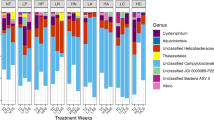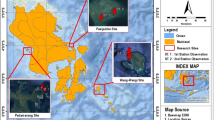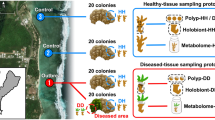Abstract
Infectious diseases are recognized as significant contributors to the dramatic loss of corals observed worldwide. However, the causes of increased coral disease prevalence and severity are not well understood. One potential factor is elevated nutrient concentration related to localized anthropogenic activities such as inadequate waste water treatment or terrestrial runoff. In this study the effect of nutrient enrichment on the progression of black band disease (BBD) was investigated using both in situ and laboratory experiments. Experimental increases in localized nutrient availability using commercial time release fertilizer in situ resulted in doubling of BBD progression and coral tissue loss in the common reef framework coral Siderastrea siderea. Laboratory experiments in which artificially infected S. siderea colonies were exposed to increased nitrate concentrations (up to 3 μM) demonstrated similar increases in BBD progression. These findings provide evidence that the impacts of this disease on coral populations are exacerbated by nutrient enrichment and that management to curtail excess nutrient loading may be important for reducing coral cover loss due to BBD.



Similar content being viewed by others
References
Antonius A (1988) Distribution and dynamics of coral diseases in the eastern Red Sea. Proc 6th Int Coral Reef Symp 3:145–150
Atkinson MJ, Carlson B, Crow GL (1995) Coral growth in high-nutrient low-pH seawater: a case study of the Waikiki Aquarium. Coral Reefs 14:1–9
Borger JL (2005) Dark spot syndrome: a scleractinian coral disease or a general stress response? Coral Reefs 24:139–144
Borger JL, Steiner SCC (2005) The spatial and temporal dynamics of coral diseases in Dominica, West Indies. Bull Mar Sci 77:137–154
Boyer JN, Jones RD (2002) A view from the bridge: external and internal forces affecting the ambient water quality of the Florida Key National Marine Sanctuary. In: Porter JW, Porter KG (eds) The Everglades, Florida Bay, and coral reefs of the Florida Keys: an ecosystem sourcebook. CRC, Boca Raton, pp 609–628
Bruckner A, Bruckner R (1997) The persistence of black band disease in Jamaica: impact on community structure. Proc 8th Int Coral Reef Symp 1:601–606
Bruno JF, Petes LE, Harvell CD, Hettinger A (2003) Nutrient enrichment can increase the severity of coral diseases. Ecol Lett 6:1056–1061
Cooney RP, Pantos O, Le Tissier MDA, Barer MR, O’Donnell AG, Bythell JC (2002) Characterization of the bacterial consortium associated with black band disease in coral using molecular microbiological techniques. Environ Microbiol 4:401–413
Costa OS Jr, Leao ZMAN, Nimmo M, Attrill MJ (2000) Nutrification impacts on coral reefs from northern Bahia, Brazil. Hydrobiologia 440:307–315
Dennis GD, Wicklund RI (1993) The relationship between environmental factors and coral bleaching at Lee Stocking Island, Bahamas in 1990. In: Ginsburg RN (ed) Proceedings of the colloquium on global aspects of coral reefs: health, hazards, and history. University of Miami Press, Miami, pp 167–173
Done TJ (1992) Phase shifts in coral reef communities and their ecological significance. Hydrobiologia 247:121–132
Edmunds PJ (1991) Extent and effect of black band disease on Caribbean reefs. Coral Reefs 10:161–165
Edmunds PJ (2000) Recruitment of scleractinians onto the skeletons of corals killed by black band disease. Coral Reefs 19:69–74
Ferrier-Pages C, Gattuso JP, Dallot S, Jaubert J (2000) Effect of nutrient enrichment on growth and photosynthesis of the zooxanthellate coral Stylophora pistillata. Coral Reefs 19:103–113
Frias-Lopez JG, Zerkle AL, Bonheyo GT, Fouke BW (2002) Partitioning of bacterial communities between seawater and healthy, black band diseased, and dead coral surface. Appl Environ Microbiol 68:2214–2228
Gardner TA, Cote IM, Gill JA, Grant A, Watkinson AR (2003) Long-term region-wide declines in Caribbean corals. Science 301:958–960
Garrett P, Ducklow P (1975) Coral disease in Bermuda. Nature 253:349–350
Genin A, Lazar B, Brenner S (1995) Vertical mixing and coral death in the Red-Sea following the eruption of Mount-Pinatubo. Nature 377:507–510
Goreau TJ, Cervino J, Goreau M, Hayes R, Hayes M, Richardson L, Smith G, DeMeyer K, Nagelkerken I, Garzon-Ferrera J, Gil D, Peters EC, Garrison G, Williams EH, Bunkley-Williams L, Quirolo C, Patterson K (1998) Rapid spread of diseases in Caribbean coral reefs. Rev Biol Trop 46:157–171
Grossart H-P, Riemann L, Azam F (2001) Bacterial motility in the seas and its ecological importance. Aquat Microb Ecol 25:247–258
Hallock P, Muller-Karger FE, Halas JC (1993) Coral-reef decline. Res Explor 9:358–378
Harvell CD, Kim K, Burkholder JM, Colwell RR, Epstein PR, Grimes DJ, Hofmann EE, Lipp EK, Osterhaus ADME, Overstreet RM, Porter JW, Smith GW, Vasta GR (1999) Emerging marine diseases—climate links and anthropogenic factors. Science 285:1505–1510
Hughes TP (1994) Catastrophes, phase shifts, and large-scale degradation of a Caribbean coral reef. Science 265:1547–1551
Hughes TP, Baird AH, Bellwood DR, Card M, Connolly SR, Folke C, Grosberg R, Hoegh-Guldberg O, Jackson JB, Kleypass J, Lough JM, Marshall P, Nystrom M, Palumbi SR, Pandolfi JM, Rosen B, Roughgarden J (2003) Climate change, human impacts, and the resilience of coral reefs. Science 301:929–933
Hunte W, Wittenberg M (1992) Effects of eutrophication and sedimentation on juvenile corals. II settlement. Mar Biol 114:625–631
Jackson JBC, Kirby MX, Berger WH, Bjorndal KA, Botsford LW, Bourque BJ, Bradbury RH, Cooke R, Erlandson J, Estes JA, Hughes TP, Kidwell S, Lange CB, Lenihan HS, Pandolfi JM, Peterson CH, Steneck RS, Tegner MJ, Warner RR (2001) Historical overfishing and the recent collapse of coastal ecosystems. Science 293:629–637
Kaczmarsky LT, Draud M, Williams EH (2005) Is there a relationship between proximity to sewage effluent and the prevalence of coral disease? Caribb J Sci 41:124–137
Kim K, Harvell CD (2002) Aspergillosis of sea fan corals: dynamics in the Florida Keys. In: Porter JW, Porter KG (eds) The Everglades, Florida Bay, and coral reefs of the Florida Keys: an ecosystem sourcebook. CRC, Boca Raton, pp 813–824
Kuntz NM, Kline DI, Sandin SA, Rohwer F (2005) Pathologies and mortality rates caused by organic carbon and nutrient stressors in three Caribbean coral species. Mar Ecol Prog Ser 294:173–180
Kuta KG, Richardson LL (1996) Abundance and distribution of black band disease of corals in the northern Florida Keys. Coral Reefs 15:219–223
Kuta KG, Richardson LL (1997) Black band disease and the fate of diseased coral colonies in the Florida Keys. Proc 8th Int Coral Reef Symp 1:575–578
Kuta KG, Richardson LL (2002) Ecological aspects of black band disease of corals: relationships between disease incidence and environmental factors. Coral Reefs 21:393–398
LaPointe BE, O’Connell JD, Garrett GS (1990) Nutrient couplings between on-site sewage disposal systems, groundwaters and nearshore surface waters of the Florida Keys. Biogeochemistry 10:289–307
Leichter JJ, Wing SR, Miller SL, Denny MW (1996) Pulsed delivery of subthermocline water to Conch Reef (Florida Keys) by internal tidal bores. Limnol Oceanogr 41:1490–1501
Leichter JJ, Stewart HL, Miller SL (2003) Episodic nutrient transport to Florida coral reefs. Limnol Oceanogr 48:1394–1407
Lipp EK, Jarrell JL, Griffin DW, Lukasik J, Jacukiewicz J, Rose JB (2002) Preliminary evidence for human fecal contamination in corals of the Florida Keys, USA. Mar Pollut Bull 44:666–670
Littler MM, Littler DS (1984) Models of tropical reef biogenesis: the contribution of algae. Prog Phycological Res 3:323–364
Nagelkerken I, Buchan K, Smith GW, Bonair K, Bush P, Garzon-Ferreira J, Botero L, Gayle P, Harvell CD, Heberer C, Kim K, Petrovic C, Pors L, Yoshioka P (1997) Widespread disease in Caribbean sea fans: I. Spreading and general characteristics. Proc 8th Int Coral Reef Symp 1:679–682
Paul JH, Rose JB, Jiang S, Kellogg C, Shinn EA (1995) Occurrence of fecal indicator bacteria in surface waters and the subsurface aquifer in Key Largo, Florida. Appl Environ Microbiol 61:2235–2241
Porter JW, Dustan P, Jaap WC, Patterson KL, Kosmynin V, Meier OW, Patterson ME, Parsons M (2001) Patterns of spread of coral disease in the Florida Keys. Hydrobiologia 460:1–24
Renegar DA, Riegl BM (2005) Effect of nutrient enrichment and elevated CO2 partial pressure on growth rate of Atlantic scleractinian coral Acropora cervicornis. Mar Ecol Prog Ser 293:69–76
Richardson L (1996) Horizontal and vertical migration patterns of Phormidium corallyticum and Beggiatoa spp. associated with black band disease of corals. Microb Ecol 32:323–335
Richardson LL (1998) Coral diseases: what is really known? Trends Ecol Evol 13:438–443
Richardson LL, Aronson RB (2002) Infectious diseases continue to degrade corals reefs. Proc 9th Int Coral Reef Symp 2:1225–1230
Richardson LL, Kuta KG (2003) Ecological physiology of the black band disease cyanobacterium Phormidium corallyticum. FEMS Microbiol Ecol 43:287–298
Richardson LL, Goldberg W, Kuta K, Aronson RB, Smith GW, Ritchie KB, Halas JC, Feingold JS, Miller SM (1998) Florida’s mystery coral killer identified. Nature 392:557–558
Rosenberg E, Ben-Haim Y (2002) Microbial diseases of corals and global warming. Environ Microbiol 4:318–326
Rosenberg E, Loya Y (eds) (2004) Coral health and disease. Springer, Berlin Heidelberg New York
Rützler K, Santavy D, Antonius A (1983) The black band disease of Atlantic reef corals. III: distribution, ecology and development. PSZNI Mar Ecol 4:329–358
Schnell S, Assmus B, Richardson LL (1996) Role of sulfate-reducing bacteria in the black band disease of corals. Annual meeting of the VAAM (Vereinigung fuer Allgemeine und Angewandte Mikrobiologie) and GBCH (Gesellschaft fuer Biologische Chemie). Biospecktrum 116
Stambler N, Popper N, Dubinsky Z, Stimson J (1991) Effects of nutrient enrichment and water motion on the coral Pocillopora damicornis. Pac Sci 45:299–307
Steneck RS, Dethier MN (1994) A functional-group approach to the structure of algal-dominated communities. Oikos 69:476–498
Sutherland KP, Porter JW, Torres C (2004) Disease and immunity in Caribbean and Indo-Pacific zooxanthellate corals. Mar Ecol Prog Ser 266:273–302
Szmant AM (2002) Nutrient enrichment on coral reefs: is it a major cause of coral reef decline? Estuaries 25:743–766
Szmant AM, Forrester A (1996) Water column and sediment nitrogen and phosphorus distribution patterns in the Florida Keys, USA. Coral Reefs 15:21–41
Taylor DL (1978) Nutrition of algal-invertebrate symbiosis. II. Effects of exogenous nitrogen sources on growth, photosynthesis and the rate of excretion by algal symbionts in vivo and in vitro. Proc R Soc Lond B Biol Sci 201:401–412
Taylor D (1983) The black band disease of Atlantic reef corals. II. Isolation, cultivation, and growth of Phormidium corallyticum. PSZNI Mar Ecol 4:320–328
Viehman TS, Mills DK, Meichel GW, Richardson LL (2006) Culture and identification of Desulfovibrio spp. from corals infected by black band disease on Dominican and Florida Keys reefs. Dis Aquat Organ 69:119–127
Voss JD, Richardson LL (2006) Coral diseases near Lee Stocking Island, Bahamas: patterns and potential drivers. Dis Aquat Organ 69:33–40
Weil E (2004) Coral disease in the wider Caribbean. In: Rosenberg E, Loya Y (eds) Coral health and disease. Springer, Berlin Heidelberg New York, pp 35–68
Weil E, Urreiztieta I, Garzon-Ferreira J (2002) Geographic variability in the incidence of coral and octocoral diseases in the wider Caribbean. Proc 9th Int Coral Reef Symp 2:1231–1238
Acknowledgments
We gratefully acknowledge Elizabeth Remily, Jorge Pinzón, and Catherine Booker for invaluable field assistance and Chad Husby for helpful discussion regarding statistical analysis. We also thank Drew Harvell, Howard Lasker, and one anonymous reviewer for helpful comments on the manuscript. Sample collections in the Bahamas were carried out under Bahamian Department of Fisheries permit MAF/FIS/79. This research was funded by an Environmental Protection Agency STAR MAI graduate fellowship to JDV (U-91608601-0), grants from the National Oceanographic and Atmospheric Administration’s Caribbean Marine Research Center (CMRC-03-PRJV-01-03C, CMRC-04-PRJV-01-04C, CMRC-05-PRJV-01-05C) to JDV and LLR, a National Fish and Wildlife Foundation Budweiser Conservation Fellowship to JDV, a FIU Dissertation Year Fellowship to JDV, and partial funding by the National Institutes of Health (NIH/NIGMS S06GM8205) to LLR. This is contribution 112 from the Tropical Biology Program at FIU. Views expressed herein are those of the authors(s) and do not necessarily reflect the views of CMRC, NOAA, or any of their sub-agencies.
Author information
Authors and Affiliations
Corresponding author
Additional information
Communicated by Biology Editor H.R. Lasker
Rights and permissions
About this article
Cite this article
Voss, J.D., Richardson, L.L. Nutrient enrichment enhances black band disease progression in corals. Coral Reefs 25, 569–576 (2006). https://doi.org/10.1007/s00338-006-0131-8
Received:
Accepted:
Published:
Issue Date:
DOI: https://doi.org/10.1007/s00338-006-0131-8




